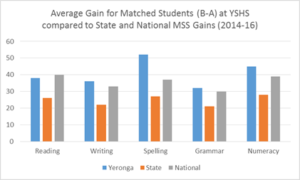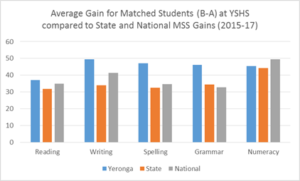The Teaching ESL students in mainstream classrooms (TESMC) course is a widely-acclaimed professional development program for all teachers seeking to implement an explicit, language-based pedagogy across all learning contexts. A key focus of the course is developing teachers’ knowledge about language to ensure that they are effectively equipped to support students to comprehend and compose texts in all areas of learning and therefore improve students’ learning outcomes.
Yeronga State High School (YSHS) has been implementing the course since 2013 and has seen excellent literacy progress in the schools’ students.
Holly Haswell-Smith, Literacy Coach at YSHS, attributes much of this success to the whole-school language and literacy focus, which includes the school-wide implementation of the TESMC course.
Background
YSHS is located in the south of Brisbane, in Queensland, Australia. The school has a very high ESL[1] population with students who enrol from:
- Milpera State High School (the main specialist reception centre for students who come from language backgrounds other than English and are newly arrived in Australia)
- feeder primary (elementary) schools
- other schools that address the needs of ESL students
- outside Australia but do not go to any intermediary schools.
Learners are placed in ESL classes where they continue to receive intensive English support while they are gradually integrated into mainstream classes[2].
Whole-school implementation
In 2013, the school sent two teachers to the TESMC Tutor Training in order to progressively train all staff within the school. Today, almost every teacher in the school (including the administration) has completed the course.
The crucial features of the successful implementation that the school has identified are listed below:
- The completion of the TESMC course is mandatory for all teachers, including the administration and new staff.
- There are, at all times, three trained TESMC tutors in the school. When a trained tutor leaves, the school ensures a new teacher undertakes the tutor training.
- The course is run every year in Semester 1 over a 10-week term.
- The course is run over 5 sessions (2 modules per day) every two weeks from 8.30am to 2.40pm.
- Groups consist of about 15 teachers.
Results
The National Assessment Program – Literacy and Numeracy (NAPLAN)[3] data below provide evidence of the literacy improvement in the school’s students.
Tables 1 and 2 below represent the average gain in students’ Mean Scale Score (MSS) over the course of two years, for the years 2014 to 2016 respectively and for the years 2015 to 2017.
The 2014-2016 students have seen their MMS in spelling improve by over 50%, compared with just under 30% at the state level and just under 40% at the national level.
Table 1: Average Gain for Matched Students[4] (B-A) at YSHS (2014-16)
The results for the 2015-2017 cohort are even stronger, suggesting that the systematic implementation of TESMC in the school has contributed to ongoing academic success. As observed in Table 2, the students have seen their MMS improve at a faster rate than both the state and national rate in reading, writing, spelling and grammar.
Table 2: Average Gain for Matched Students (B-A) at YSHS (2015-17)
In summary
The TESMC course and its careful and systematic implementation over recent years appears to have combined with other language and literacy support strategies to produce such excellent results at YSHS.
[1] Currently in Australia, the term ‘ESL’ (English as a Second Language) has generally been replaced by ‘EALD’ (English as an Additional Language or Dialect). EALD acknowledges that many English language learners already speak two or more languages before beginning to learn English. It also acknowledges that some students already speak a dialect of English and are learning standard Australian English.
[2] Source: https://yerongashs.eq.edu.au/Curriculum/Subjectsandprograms/Pages/English-as-a-Second-Language-or-Dialect-(EALD).aspx
[3] The NAPLAN is a series of tests administered annually to Australian students in Years 3, 5, 7 and 9. These standardised tests assess students’ reading, writing, spelling, grammar, punctuation, and numeracy.
[4] The term ‘Matched Students (B-A)’ refers to students who have taken both test A in Year 7 and Test B in Year 9 (two-years growth) in the school.


